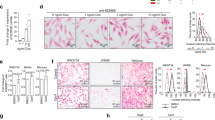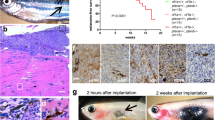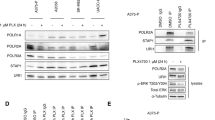Abstract
A major obstacle in the systemic treatment of advanced malignant melanoma is its intrinsic resistance to conventionally used chemotherapeutic agents. In order to investigate the mechanisms of this intrinsic resistance, we have previously utilized retroviral insertional mutagenesis on an early-stage, drug sensitive human melanoma cell line (WM35) to establish mutated cell lines that exhibited increased resistance to cis-diamminedichloroplatinum(II) (CDDP). Here, we demonstrate that this increased resistance to CDDP is mediated by the over-expression of tyrosinase-related protein-2 (TYRP2), an enzyme that normally functions in the biosynthesis of the pigment, melanin. Northern and Western blot analyses revealed that the expression of TYRP2 in the virally-derived cell lines as well as in a panel of human melanoma cell lines positively correlated with their levels of resistance to CDDP. Furthermore, enforced expression of TYRP2 in WM35 cells by transfection elevated their resistance to CDDP. The increased CDDP resistance in the virally-derived clones and TYRP2 transfectants was accompanied by a reduction in CDDP-induced apoptosis. Interestingly, the virally-derived CDDP-resistant clones also showed cross resistance to carboplatin and methotrexate, but not taxol, suggesting that TYRP2 over-expression may confer resistance specifically to DNA damaging agents. Overall, these results demonstrate a novel mechanism of drug resistance in human melanoma cells that is mediated by the over-expression of TYRP2. Since TYRP2 is expressed only in cells of melanocytic lineage, this may represent the first report of a lineage-specific mechanism of drug resistance. In summary, these findings suggest a significant role for TYRP2 in the intrinsic drug resistance phenotype of human melanoma cells and may have important implications in the development of chemosensitization strategies for the clinical management of this disease.
This is a preview of subscription content, access via your institution
Access options
Subscribe to this journal
Receive 50 print issues and online access
$259.00 per year
only $5.18 per issue
Buy this article
- Purchase on Springer Link
- Instant access to full article PDF
Prices may be subject to local taxes which are calculated during checkout






Similar content being viewed by others
References
Andrews PA, Murphy MP and Howell SB. . 1985 Cancer Res. 45: 6250–6253.
Aroca P, Garcia-Borron JC, Solano F and Lozano JA. . 1990 Biochim. Biophys. Acta. 1035: 266–275.
Balch CM, Houston A and Peter L. . 1989 Cutaneous melanoma. In: Cancer: Principles and Practices of Oncology. 3rd edn. De Vita VT, Hellman S and Rosenberg SA. (eds). Lippincott: Philadelphia pp 1499–1542.
Bartholomew C, Morishita K, Askew D, Buchberg A, Jenkins NA, Copeland NG and Ihle JN. . 1989 Oncogene 4: 529–534.
Batist G, Tulpule A, Sinha BK, Katki AG, Myers CE and Cowan KH. . 1986 J. Biol. Chem. 261: 15544–15549.
Bernd A, Ramirez-Bosca A, Kippenberger S, Martinez-Liarte JH, Holzmann H and Solano F. . 1994 Melanoma Res. 4: 287–291.
Borchers AH, Kennedy DA and Straw JA. . 1990 Cancer Res. 50: 1786–1789.
Chan HS, Lu Y, Grogan TM, Haddad G, Hipfner DR, Cole SP, Deeley RG, Ling V and Gallie BL. . 1997 Cancer Res. 57: 2325–2330.
Chu G. . 1994 J. Biol. Chem. 269: 787–790.
Chu G and Chang E. . 1990 Proc. Natl. Acad. Sci. USA 87: 3324–3327.
Citro G, D'Agnano I, Leonetti C, Perini R, Bucci B, Zon G, Calabretta B and Zupi G. . 1998 Cancer Res. 58: 283–289.
Cole SPC, Bhardwaj G, Gerlach JH, Mackie JE, Grant CE, Almquist KC, Stewart AJ, Kurz EU, Duncan AM and Deeley RG. . 1992 Science 258: 1650–1654.
Dolan ME, McRae BL, Ferries-Rowe E, Belanich M, van Seventer GA, Guitart J, Pezen D, Kuzel TM, Yarosh DB. . 1999 Clin. Cancer Res. 5: 2059–2064.
Fillpits M, Suchomel RW, Dekan G, Stiglbauer W, Haider K, Depisch D and Pirker R. . 1997 Br. J. Cancer 75: 208–212.
Ho RCS. . 1995 Cancer 75: 735–741.
Ishikawa T, Wright CD and Ishizuka H. . 1994 J. Biol. Chem. 269: 29085–29093.
Jackson IJ, Chambers DM, Tsukamoto K, Copeland NG, Gilbert DJ, Jenkins NA and Hearing V. . 1992 EMBO J. 11: 527–535.
Jansen B, Schlagbauer-Wadl H, Brown BD, Bryan RN, van Elsas A, Muller M, Wolff K, Eichler HG and Pehamberger H. . 1998 Nat. Med. 4: 232–234.
Kartner N, Everden-Portelle D, Bradley G and Ling V. . 1986 Nature 316: 820–823.
Kawakami Y, Robbins PF, Wang RF, Parkhurst M, Kang X and Rosenberg SA. . 1998 J. Immunother. 21: 237–246.
Koo HM, Gray-Goodrich M, Kohlhagen G, McWilliams MJ, Jeffers M, Vaigro-Wolff A, Alvord WG, Monks A, Paull KD, Pommier Y and Vande Woude GF. . 1999 J. Natl. Cancer Inst. 91: 236–244.
Kung HJ, Boerkoel C and Carter TH. . 1991 Curr. Top. Microbiol. Immunol. 171: 1–25.
Kuroda H, Sugimoto T, Ueda K, Tsuchida S, Horii Y, Inazawa J, Sato K and Sawada T. . 1991 Int. J. Cancer 47: 732–737.
Lai G-M, Ozols RF, Smyth JF, Young RC and Hamilton TC. . 1988 Biochem. Pharm. 37: 4597–4600.
Lai GM, Ozols RF, Young RC and Hamilton TC. . 1989 J. Natl. Cancer Inst. 81: 535–539.
Lazebnik YA, Kaufmann SH, Desnoyers S, Poirier GG and Earnshaw WC. . 1994 Nature 371: 346–347.
Legrand O, Simonin G, Zittoun R and Marie JP. . 1998 Leukemia 12: 1327–1328.
Leonard LJ, Townsend D and King RA. . 1988 Biochemistry 27: 6156–6159.
Lorico A, Toffoli G, Boiocchi M, Erba E, Broggini M, Rappa G and D'Incalci M. . 1988 Cancer Res. 48: 2036–2041.
Lu SJ, Man S, Bani MR, Adachi D, Hawley RG, Kerbel RS and Ben-David Y. . 1995 Cancer Res. 55: 1139–1145.
Miyake H, Hanada N, Nakamura H, Kagawa S, Fujiwara T, Hara I, Eto H, Gohji K, Arakawa S, Kamidono S and Saya H. . 1998 Oncogene 16: 933–943.
Moriwaki S, Nishigori C, Takebe H, Imamura S. . 1992 J. Dermatol. Sci. 4: 6–10.
Orlow SJ, Hearing VJ, Sakai C, Urabe K, Zhou BK, Silvers WK and Mintz B. . 1995 Proc. Natl. Acad. Sci. USA 92: 10152–10156.
Overwijk WW, Lee DS, Surman DR, Irvine KR, Touloukian CE, Chan CC, Carroll MW, Moss B, Rosenberg SA and Restifo NP. . 1999 Proc. Natl. Acad. Sci. USA 96: 2982–2987.
Parkhurst MR, Fitzgerald EB, Southwood S, Sette A, Rosenberg SA and Kawakami Y. . 1998 Cancer Res. 58: 4895–4901.
Pawelek JM. . 1990 Biochem. Biophys. Res. Commun. 166: 1328–1333.
Peters G, Lee AE and Dickson C. . 1986 Nature 320: 628–631.
Tief K, Schmidt A and Beermann F. . 1998 Brain Res. Mol. Brain Res. 53: 307–310.
Tsukamoto K, Jackson IJ, Urabe K, Montague PM and Hearing VJ. . 1992 EMBO J. 11: 519–526.
Young RC. . 1989 Drug resistance: The clinical problem. In: Drug Resistance in Cancer Therapy. Kluwer Academic Press: Philadelphia.
Zhen W, Link CJ, O'Connor PM, Reed E, Parker R, Howell SB and Bohr VA. . 1992 Mol. Cell. Biol. 12: 3689–3698.
Acknowledgements
The authors would like to thank Dr Rick Sturm (University of Queensland, Australia) for generously providing TYRP2 cDNA, Dr Vincent J Hearing (National Cancer Institute, Bethesda, MD, USA) for the αPEP8 TYRP2 polyclonal antibody and Dr Meenhard Herlyn (Wistar Institute, Philadelphia, PA, USA) for kindly providing the human melanoma cell lines. We also thank Dr Janusz Rak for helpful discussions and comments on the manuscript. This work was supported by grants from the Medical Research Council of Canada and the National Cancer Institute of Canada to Y Ben-David and the National Institutes of Health, USA (CA-41233) to RS Kerbel. BJ Pak is a recipient of the Sunnybrook Trust for Medical Research postdoctoral fellowship.
Author information
Authors and Affiliations
Rights and permissions
About this article
Cite this article
Chu, W., Pak, B., Bani, M. et al. Tyrosinase-related protein 2 as a mediator of melanoma specific resistance to cis-diamminedichloroplatinum(II): therapeutic implications. Oncogene 19, 395–402 (2000). https://doi.org/10.1038/sj.onc.1203315
Received:
Revised:
Accepted:
Published:
Issue Date:
DOI: https://doi.org/10.1038/sj.onc.1203315
Keywords
This article is cited by
-
Dendritic cell vaccination combined with temozolomide retreatment: results of a phase I trial in patients with recurrent glioblastoma multiforme
Journal of Neuro-Oncology (2015)
-
Melanogenesis inhibition of β-lapachone, a natural product from Tabebuia avellanedae, with effective in vivo lightening potency
Archives of Dermatological Research (2015)
-
Heterogeneous SWI/SNF chromatin remodeling complexes promote expression of microphthalmia-associated transcription factor target genes in melanoma
Oncogene (2010)
-
HIF-1 antagonizes p53-mediated apoptosis through a secreted neuronal tyrosinase
Nature (2010)
-
Purification and N-Glycosylation Analysis of Melanoma Antigen Dopachrome Tautomerase
The Protein Journal (2010)



